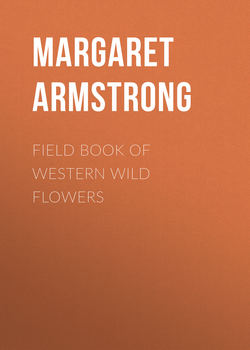Читать книгу Field Book of Western Wild Flowers - Armstrong Margaret - Страница 8
SANDALWOOD FAMILY. Santalaceae
ОглавлениеThis is a very small family in this country, for they prefer the tropics, and in those regions some are trees. Ours are usually parasitic on the roots of their neighbors. They have toothless, mostly alternate leaves, mostly without leaf-stalks or stipules, and small flowers, with a four- or five-lobed calyx and no corolla. The four or five stamens are opposite the calyx lobes, at the edge of a fleshy disk, and the ovary is one-celled and inferior, with one style, developing into a one-seeded fruit.
There are four kinds of Comandra, one of them European; smooth, perennial herbs, with alternate leaves, and flowers in clusters, without bracts. The calyx is more or less bell-shaped, usually with five lobes, its tube lined with a disk, the stamens inserted at base of the lobes and the anthers attached to the lobes by tufts of hairs.
Pale Comandra
Comándra pállida
Flesh-color, greenish, purplishSpring, summer
Northwest, Nev., Utah, Ariz.
This is a rather pretty plant, growing from a few inches to about a foot tall, branching and rather woody below, with pale-green, smooth, slightly thickish, rather stiff leaves, which are reduced to pinkish scales on the lower stem. The flowers are small, usually flesh-color, thickish in texture, with slender pedicels, and form terminal, rather flat-topped clusters. The fruit, which is about the size of a small pea, is crowned by the remains of the calyx, like a rose-hip. This is common on dry plains and hillsides and is noticeable because of its pale and somewhat peculiar coloring.
Pale Comandra – C. pallida.
